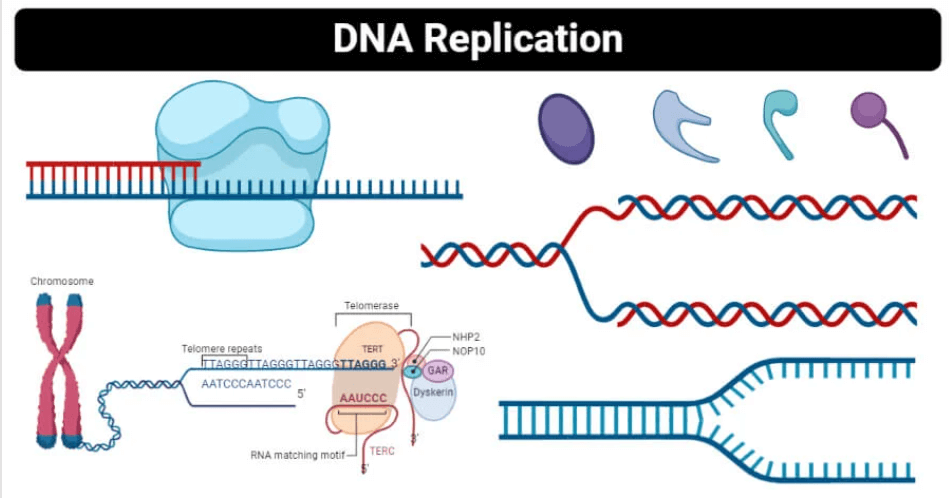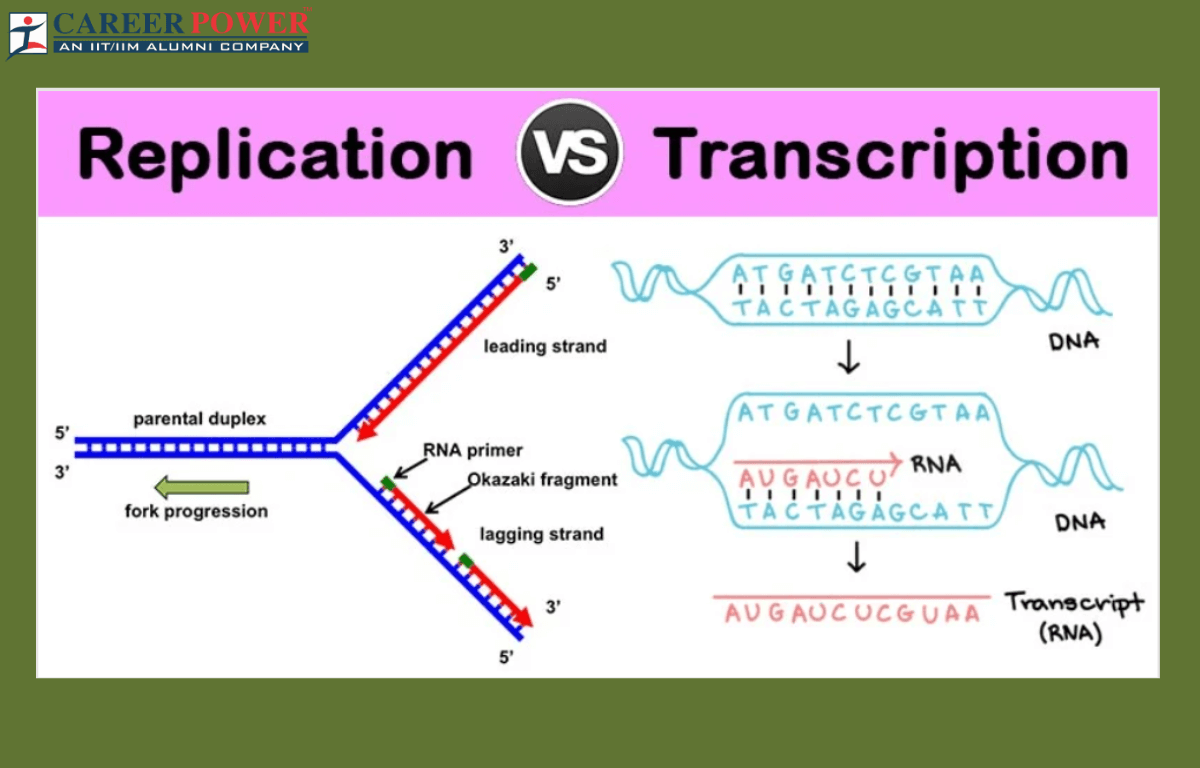Replication and Transcription
Replication is the process of copying DNA to create an identical double-stranded DNA molecule. It occurs during cell division. Transcription, on the other hand, is the synthesis of RNA from a DNA template. It’s a crucial step in gene expression, converting genetic information into RNA molecules like mRNA. For more information about Replication and Transcription read the complete article below.
Define Replication
Replication is like making a copy of something. In the context of DNA, it’s the process cells use to duplicate their genetic material. Imagine your DNA is a book of instructions that tells your body how to grow and function. During replication, the cell unzips the DNA, creating two separate strands. Each strand then serves as a template to build a new complementary strand. Think of it as a photocopy of the original book.

The result is two identical sets of instructions, ensuring that when cells divide, each new cell gets a complete and accurate set of genetic information. DNA Replication is vital for the growth, development, and maintenance of the integrity of genetic material across generations. It’s like nature’s way of ensuring that the essential information for life gets passed on accurately.
Define Transcription
In Biology, transcription refers to the essential process by which genetic information encoded in DNA is converted into RNA (ribonucleic Acid). This is a critical step in the central dogma of molecular biology, where genetic instructions are translated into functional molecules. Here’s a simplified breakdown: Within a cell’s Nucleus, DNA serves as the master blueprint containing genes. Transcription begins when an enzyme called RNA polymerase binds to a specific region of DNA called a promotor.

The RNA polymerase then reads the DNA sequence and synthesizes a complementary RNA strand, following the rules of base pairing (A with U in RNA, G with C). The resulting RNA, known as messenger RNA (mRNA), carries the genetic information from the nucleus to the cell’s cytoplasm. There, it serves as a template for protein synthesis during translation. Essentially, transcription is the first step in the intricate process of translating genetic instructions into the proteins that carry out various functions within living organisms.
Difference Between Replication and Transcription
Below we have discussed a few differences between Replication and Transcription. These differences will highlight the distinct roles and processes involved in DNA replication and transcription within a cell.
| Difference Between Replication and Transcription | ||
| Features | Replication | Transcription |
| Purpose | Replication involves copying the entire DNA molecule to create an identical copy. | Transcription involves copying a specific segment of DNA to create a complementary RNA molecule. |
| Enzyme Involved | DNA polymerase is the key enzyme responsible for synthesizing a new DNA strand. | RNA polymerase is the enzyme that synthesizes RNA using the DNA template. |
| End Product | Replication results in the formation of two identical DNA molecules. | Transcription produces a single-stranded RNA molecule complementary to the DNA template. |
| Location | Occurs in the nucleus in eukaryotes and in the cytoplasm in prokaryotes. | Transcription primarily occurs in the nucleus of Eukaryotic cells. |
| Template Strand | Both DNA strands act as a template for the synthesis of new strands. | Only one DNA strand (the template strand) is used to synthesize RNA. |
| Product Stability | DNA products are generally more stable and longer-lived. | RNA molecules are generally more stable and have a shorter lifespan. |
| End Result Function | Replication provides genetic material for the daughter cells during cell division. | Transcription serves as a template for protein synthesis during translation. |
| Number of Processes | A single, continuous process during cell division. | A recurring process that happens each time a specific gene is expressed. |
| Initiation Point | Typically initiated at specific sites called origins of replication. | Transcription is typically initiated at the promoter region of a gene. |
| Product Modification | The end product, DNA usually undergoes little to no modification. | The RNA product may undergo various modifications (e.g., splitting, addition of a cap and tail) before becoming functional. |
Functions of Replication and Transcription
Replication is the process of copying DNA to produce an identical copy, ensuring genetic continuity during cell division. Transcription, on the other hand, involves the synthesis of RNA from a DNA template, providing the instructions for protein synthesis. Other functions of Replication and Transcription are discussed below.
Functions of Replication
These functions collectively contribute to the maintenance and transmission of genetic information, essential for the survival and adaptability of living organisms.
- The primary function of DNA replication is to produce an identical copy of the genetic material (DNA). This ensures that each new cell receives a complete set of genetic instructions.
- DNA replication is closely linked to cell division. Before a cell divides, it needs to replicate its DNA so that each daughter cell gets a complete set of genetic information.
- DNA replication includes mechanisms for error correction. Enzymes proofread the newly synthesized DNA strands, fixing any errors in the sequence to maintain the accuracy of genetic information.
- Through accurate DNA replication, the genetic information is faithfully passed from one generation of cells to the next, ensuring the continuity of traits and characteristics.
- Replication provides the template for gene expression. The transcribed RNA is derived from one of the DNA strands, and this RNA serves as a template for protein synthesis.
Functions of Transcription
Transcription is a crucial step in the process of gene expression, where information encoded in DNA is transcribed into RNA. The primary functions of transcription include:
- Transcription is the process by which an RNA molecule is synthesized using a DNA template. This RNA molecule, known as messenger RNA (mRNA), carries the genetic information from the DNA to the ribosomes for protein synthesis.
- Transcription allows the cell to access specific genes by producing complementary RNA sequences. This RNA, in turn, serves as a blueprint for the synthesis of proteins or, in the case of non-coding RNAs, performs various regulatory functions within the cell.
- Different cell types in multicellular organisms express different sets of genes. Transcription plays a key role in cellular differentiation by selectively activating or deactivating specific genes, leading to the development of distinct cell types and tissues.
- Transcriptional regulation controls when and to what extent a gene is transcribed. Transcription factors and other regulatory proteins influence the binding of RNA polymerase to the promoter region of a gene, thereby modulating the rate of transcription.



 50 Vegetables Name for Kids in English a...
50 Vegetables Name for Kids in English a...
 Food Chain: Definition, Types, Examples,...
Food Chain: Definition, Types, Examples,...
 Human Respiratory System: Definition, Di...
Human Respiratory System: Definition, Di...













